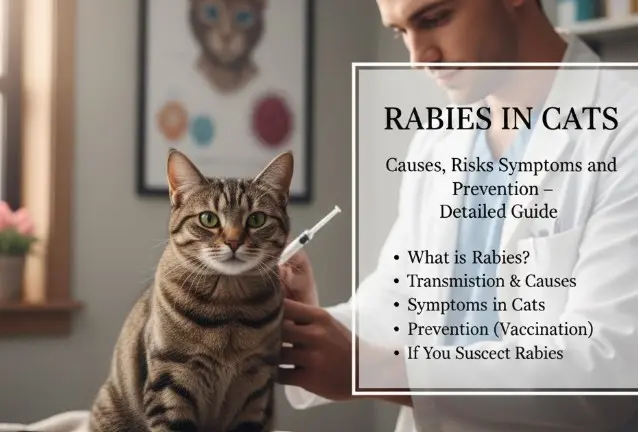Rabies is a neurotropic viral infection that targets the central nervous system. Once a cat is infected, the virus travels through the nerves to the spinal cord and brain, causing irreversible neurological damage.
Cats usually contract rabies after being bitten by an infected animal, such as a wild animal, stray cat, or unvaccinated dog. Outdoor cats are at higher risk because of potential encounters with wildlife or other infected animals. Even indoor cats are not completely safe, as they may escape or encounter contaminated animals indirectly.
Regular vaccination is critical, not only for the cat’s protection but also to prevent potential transmission to humans.
How Rabies Spreads Between Cats and Humans
Rabies is a zoonotic disease, meaning it can pass from animals to humans. In cats, transmission occurs primarily through bites, where the infected animal’s saliva enters the bloodstream. Less commonly, saliva contacting an open wound or mucous membrane can transmit the virus.
Scratches alone rarely transmit rabies, but if saliva from an infected cat contaminates a scratch or open wound, risk increases. Prompt medical attention is essential after any potential exposure.
Cats can also spread rabies to other animals through bites or close contact, making vaccination and monitoring essential for households with multiple pets.
Recognizing Rabies Symptoms in Cats
The incubation period of rabies in cats varies from 3 to 8 weeks, though it can occasionally be as short as 10 days or extend up to a year. The course of the disease is divided into three stages: prodromal, furious, and paralytic.
Prodromal Stage (Early Signs)
- Lasts 1–3 days
- Subtle behavioral changes: hiding, restlessness, unusual affection or fear
- Slight fever, decreased appetite, mild difficulty swallowing, increased salivation
This stage is often overlooked, yet it is when early intervention could be most beneficial.
Furious Stage (Hyperactivity and Aggression)
- Dramatic behavioral changes: sudden aggression, hyperactivity, unpredictable attacks
- Hypersensitivity to light and sound, excessive vocalization, drooling
- The cat may attack familiar people or other pets
- Usually lasts a few days and represents the period of highest danger
Paralytic Stage (Dumb Phase)
- Final stage: paralysis begins in the hind legs and spreads throughout the body
- Loss of swallowing ability, respiratory failure, inability to eat or drink
- Rapid progression; death typically occurs within 24–48 hours after onset
Once a cat reaches the paralytic stage, recovery is almost impossible, and humane euthanasia may be recommended to prevent suffering.
Diagnosis and Observation
While definitive rabies diagnosis requires laboratory testing post-mortem, veterinarians rely on behavioral and neurological signs for strong suspicion. Early warning signs include:
- Sudden aggression or extreme docility
- Hiding or excessive vocalization
- Drooling or difficulty swallowing
- Uncoordinated movements or weakness in hind legs
Veterinarians also consider vaccination status, outdoor exposure, and recent animal interactions to determine next steps.
Preventing Rabies in Cats
Since rabies is incurable once symptoms appear, prevention is key.
Vaccination
- Vaccines are safe, effective, and strongly recommended for all cats
- Even indoor cats should be vaccinated, as accidental exposure is possible
- Follow your veterinarian’s recommended vaccination schedule for boosters and maintenance
Limiting Exposure
- Supervise outdoor activity or restrict cats to safe indoor areas
- Avoid contact with stray or feral animals
- Prevent interactions with wildlife such as bats, raccoons, or foxes
- Keep windows and doors secured to reduce accidental contact
By combining vaccination with careful environmental management, you protect your cat and household from rabies risk.
What to Do After Potential Exposure
If a Cat Is Bitten
- Wash wounds immediately with soap and water
- Seek veterinary care promptly
- Notify local authorities if necessary for quarantine and observation
If a Human Is Bitten
- Clean the wound immediately and seek medical care
- Provide information about the cat’s vaccination status
- Post-exposure prophylaxis (PEP) may be recommended for unvaccinated or unknown-status cats
Suspected Rabid Cat
- Avoid contact; isolate the cat in a secure area
- Consult a veterinarian and follow local health regulations
- Early isolation helps protect other pets and humans
Common Questions
Is indoor cat vaccination necessary?
Yes. Even indoor cats may escape or have indirect contact with infected animals. Vaccination is the safest protection.
Can a cat scratch transmit rabies?
Rarely. Transmission through scratches is possible only if contaminated with saliva and the scratch breaks the skin.
Once a cat shows symptoms, can it recover?
No. Rabies is nearly always fatal once clinical signs appear. Prevention is the only effective strategy.
How long does a cat survive after symptoms appear?
Typically 3–7 days, depending on viral progression and neurological damage.
Are kittens more vulnerable?
Yes, due to their undeveloped immune systems. Symptoms may progress faster and be more severe.
Conclusion
Rabies in cats is a serious but preventable disease. Awareness, regular vaccination, minimizing outdoor risk, and immediate response to bites or scratches are essential. Protecting your cat not only safeguards their life but also prevents potential transmission to humans and other animals.
Prioritize vaccination, supervise your cat, and consult a veterinarian immediately if exposure occurs. Preventive action saves lives.

